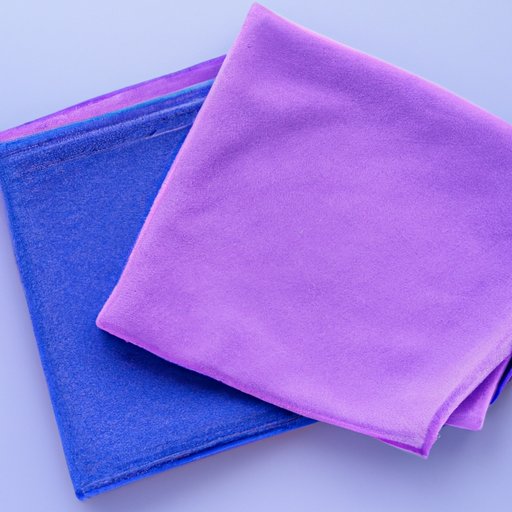
Introduction
Microfiber cloth is an incredibly popular material that is used in both cleaning and beauty. It is extremely efficient at holding onto dirt, dust, and oils that are collected in its fibers and is capable of cleaning surfaces with just water. However, cleaning these cloths can be tricky. Luckily, with our step-by-step guide, DIY cleaning solutions, and tips for properly caring for microfiber cloths, you’ll never struggle with keeping your cleaning staples clean again.
Top Tips for Cleaning Microfiber Cloths: A Step-by-Step Guide
Microfiber cloths are an important tool in maintaining a clean and sanitary home environment. They are ideal for cleaning various surfaces such as countertops, mirrors, and more. Cleaning microfiber cloths is extremely important for ensuring their effectiveness. Here’s how to clean your microfiber cloths:
Step 1: Shake off any loose debris
Before washing your cloths, shake them out to remove any loose dirt, dust, or debris. This is an essential step as it not only helps to preserve your washer but also prevents any larger debris from getting trapped in the fibers and ruining the cloth.
Step 2: Pre-wash the cloth
Fill a sink or bucket with warm water and a small amount of laundry detergent. Gently agitate the cloth in the water and let it soak for 15-20 minutes. This helps to loosen up any built-up dirt, grime, or oils that might be present and prepares it for a deeper clean.
Step 3: Wash the cloth in the washing machine
Once you have completed pre-washing the cloth, it is time to wash it in the washing machine. Set the machine to a cold water cycle and select the delicate setting. Make sure not to use fabric softener as this can damage the microfibers and reduce their effectiveness. Wash the cloth on its own or with other light-colored cloths that require the same washing method.
Step 4: Dry the cloth
After the wash cycle is complete, remove the cloth from the washing machine and hang it to dry. If you must use a dryer, set it to the lowest heat setting possible and avoid using dryer sheets as they can also damage the fibers. Make sure the cloth is completely dry before storage.
Step 5: Store the cloth properly
Once the cloth is dry, fold it or store it in an air-tight container until you need to use it again.
The Science Behind Cleaning Microfiber Cloths: Understanding the Materials
The microfiber material is made up of tiny fibers that are electrostatically charged to attract dirt, dust, and grime. These fibers are small enough to pick-up bacteria and allergens, providing a cleaner experience. The unique properties of the microfibers, such as their density and absorbency, make them ideal for cleaning. To ensure the effectiveness of microfiber cloths, be mindful of the cleaning materials used. Avoid using bleach or fabric softener as they damage the fibers.
DIY Cleaning Solutions for Microfiber Cloths: Save Money and Keep Your Home Clean
There are many different cleaning solutions that can be used for microfiber cloths, but DIY alternatives are often the best choice. They are more natural than store-bought cleaners, which means they are safe for pets, children, and the environment. Here are some homemade solutions that you can make with just a few household ingredients:
Vinegar Solution
Mix equal parts water and vinegar in a spray bottle and shake well. Spray the solution onto your microfiber cloth and use it to clean surfaces.
Lemon and Baking Soda Solution
Mix a few tablespoons of baking soda with enough lemon juice to form a paste. Apply the paste to your microfiber cloth and use it to clean surfaces.
The Benefits of Using Microfiber Cloths for Cleaning: How to Care for Them Properly
Microfiber cloths are superior to other cleaning methods and tools for many reasons. They are more effective at cleaning surfaces, and they are environmentally friendly. Using microfiber cloths can save you money and effort in the long run. Remember to care for your microfiber cloths properly to ensure their effectiveness. Here are a few tips:
Wash After Each Use
Always wash your microfiber cloths after each use. This helps to remove any dirt, grime, and bacteria that they might have collected while in use.
Avoid Using Fabric Softener
Fabric softeners can damage the fibers in microfiber cloths, causing them to lose their effectiveness. Instead, try adding vinegar to the rinse cycle to soften the cloths naturally.
Troubleshooting Common Cleaning Issues with Microfiber Cloths: How to Fix and Prevent Streaks and Stains
One common issue that people face when cleaning with microfiber cloths is streaking. This usually happens when the cloth is not clean enough or is not used properly. Here are some tips for preventing streaking and removing stains:
Prevent Streaking
To prevent streaking, use a clean microfiber cloth and try not to apply too much pressure when wiping surfaces. You can also use a small amount of water to dampen the cloth.
Remove Stains
If your microfiber cloth has stains that are hard to remove, you can try soaking it in warm, soapy water for several hours. Avoid using bleach or harsh chemicals as they can damage the fibers.
Conclusion
Cleaning microfiber cloths can seem daunting, but it doesn’t have to be. By following the easy step-by-step guide, exploring the science behind miracle fibers, and making your cleaning solutions, you can keep your microfiber cloths clean and fresh. Use these tips to ensure that your cleaning routine is not only effective but also environmentally friendly. With these tools and recommendations, you’re sure to become a microfiber cleaning guru in no time.





